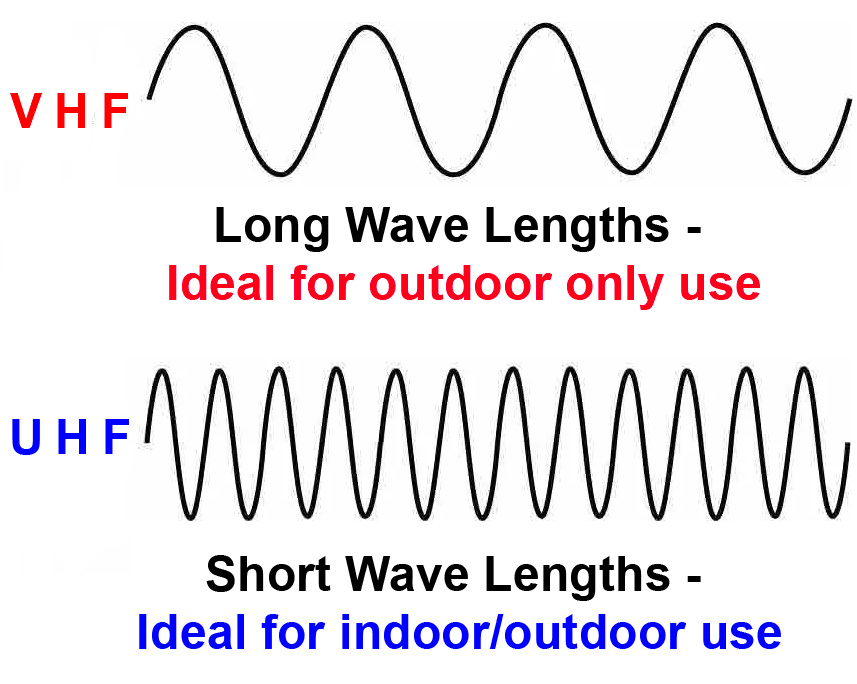The difference between VHF and UHF radios

When shopping for a business two way radio, it's important to know the differences between UHF (Ultra High Frequencies) and VHF (Very High Frequencies) walkie talkies. Not only will knowing the differences help you pick a better set of walkie talkies, but they'll also assist in proper use of radio communication on the job.
So what's the difference? Well, for starters, frequency penetration.
UHF Frequencies
UHF radio waves are short wavelengths that are tense and strong enough to penetrate steel, concrete, brick walls, and rugged terrain, which makes a UHF radio ideal for indoor-outdoor communications, or in situations where you'll need to communicate between floors of a building or in a more rugged environment.
If you are operating in a space that has multiple floors or if you need to communication within or between a building(s) - a UHF walkie talkie is the right fit for you. With the UHF waves being more compact, they have more of a spring to get around any barriers quickly. UHF radios are frequently used in restaurants, breweries, dental offices, and schools.
Examples of UHF Radios:
| Motorola | Kenwood |
| CLP1080e | NX-P1300AUK |
| CLS1410 | NX-P1300NUK |
| RMU2040 | NX-P1302AUK |
| CP100d-U |
VHF Frequencies
On the other hand, VHF radio waves have long wave lengths and aren't as strong, a little more relaxed, and can't go through the same things as UHF radio waves. Instead, VHF radios are best used when there aren't any obstructions to the signal. If you're communicating in the outdoors, a VHF two way business radio is the ideal fit for sending and receiving messages across open land, rolling hills, and thick forests.
In real-life scenarios with two-way radios, most public safety agencies in rural areas, such as sheriffs, fire departments, and EMS, opt for VHF radios. This choice is particularly prevalent in regions with low population density, hills, and valleys. Individuals engaged in activities like surveying, hiking, hunting, golf courses, and farming are also prime candidates for VHF radios.
Examples of VHF Radios:
| Motorola | Kenwood |
| RMV2080 | NX-P1200AVK |
| RDV5100 | NX-P1200NVK |
| CP100d-V | NX-P1202AVK |
| SL300-V |
UHF and VHF business two way radios also come with different features to make use easier. Some UHF radios will include a more rugged design or compatibility with headsets. Some VHF radios will offer options for use in all weather. It all depends on the radios you're looking at.
Real Life Examples of UHF and VHF Frequency Waves
You can listen to AM radio broadcasts that are hundreds of miles away from your location. This is due to AM radio stations operating within the 0.525 to 1.705 MHz frequency range, resulting in wavelengths roughly 100 times longer than VHF and 300 times longer than UHF. These longer wavelengths can sometimes fail to penetrate the Earth's atmosphere, causing them to bounce back and travel great distances.
FM radio broadcasts fall within the range of 88 to 108 MHz, approaching the VHF band. When you move 30 to 40 miles away from an FM station, you may start to experience static. This occurs because FM wavelengths are much shorter than AM, allowing them to penetrate the Earth's atmosphere (unlike AM) and travel in a more direct path, making them more susceptible to the Earth's curvature.
Frequently Asked Questions
What are the advantages/disadvantages of UHF or VHF frequencies?
- VHF: Due to its tendency to bend with the Earth's curvature, VHF is ideal for outdoor applications where long-distance communication is essential. However, VHF struggles indoors, as it does not penetrate walls or reinforced concrete as effectively as UHF.
- UHF: With its higher frequencies and shorter wavelengths, UHF radios excel at penetrating structures, making them the preferred choice for indoor communication, especially in environments with reinforced concrete. However, UHF's outdoor range is typically shorter compared to VHF.
Can UHF and VHF Radios Communicate With Each Other?
As it turns out, UHF and VHF radios cannot communicate with one another.
What are the frequency ranges for VHF and UHF radios?
- VHF radios operate within the 138-174 MHz frequency range
- UHF radios operate in the 400-512 MHz frequency range
Are UHF radios better than VHF?
It completely depends on the type of environment the radio will be used. If working in an area with obstacles, like walls, stairs and floors - UHF radios will be the best option because the waves are tightly wound and will bounce around quickly for clear communication. For areas with minimal obstacles, like rolling hills on a golf course, a VHF radio will give the the long distance communication you need.
At TechWholesale.com, we carry both UHF and VHF business walkie talkies that are perfect for meeting your two way radio needs. Shop our selection today!
Need help finding the right walkie talkie for you? Let us know and we will be more than happy to help!
